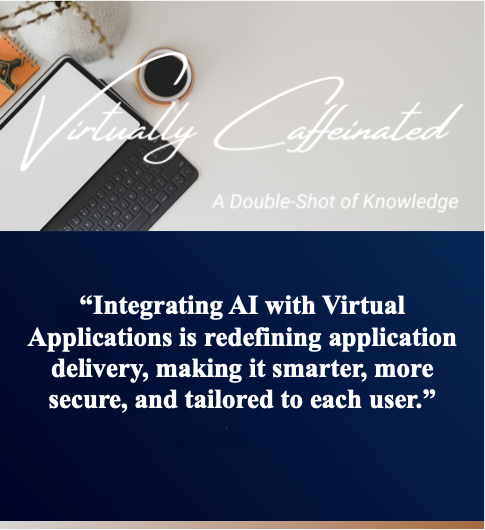Omnissa vApp and AI: Transforming Application Delivery in 2025
The way we deliver, manage, and secure applications is undergoing a revolutionary shift. In 2025, it’s not enough to simply provide users with the tools they need; organizations must deliver these tools faster, smarter, and more securely than ever before. Enter Omnissa vApp, a technology that has already streamlined application delivery by decoupling apps from operating systems. Now, with the integration of Artificial Intelligence (AI), Omnissa vApp is pushing the boundaries of what’s possible, from predicting performance needs to personalizing user experiences and safeguarding sensitive data.
Decoupling Applications: The Core Concept of vApp
At the heart of Omnissa vApp’s innovation lies a straightforward yet transformative idea: applications no longer need to be installed directly on the operating system. Instead, vApps are packaged into virtual disks that are mounted when needed. This separation brings multiple advantages. IT teams no longer have to create multiple “golden images” for various departments or user groups. Instead, they maintain a clean OS image and attach the required apps on demand. Updates, patches, and new software rollouts happen seamlessly without the need for re-imaging devices or extensive downtime. This efficiency, when paired with AI, opens up a whole new realm of possibilities.
AI-Driven Monitoring and Resource Management
One of the most immediate benefits AI brings to the table is enhanced monitoring. Traditional monitoring tools rely on predefined thresholds and static rules. When a metric exceeds a certain value, an alert is triggered. AI, on the other hand, doesn’t just react to metrics—it learns from them. With AI embedded into vApp, performance data is continuously analyzed. Over time, patterns emerge: perhaps a particular application uses significantly more memory on Monday mornings, or a certain department’s workload peaks at the end of the quarter. AI recognizes these patterns, enabling the system to proactively adjust resources before issues arise.
Imagine a scenario where a finance application consistently experiences slowdowns on the first of every month due to heavy usage. Instead of waiting for complaints to roll in, AI in vApp notices the trend and automatically allocates additional CPU and memory to handle the workload. Once the peak usage period passes, resources are scaled back. This dynamic allocation not only maintains application performance but also reduces wasted computing power, ultimately saving money.
Predictive Maintenance and Proactive Support
AI doesn’t just monitor performance—it also predicts the future. With enough data, AI can identify early warning signs that a particular application or system component might fail. This predictive maintenance capability means IT teams can address issues before they lead to downtime. For example, if AI detects that a certain application’s memory usage steadily increases after each patch, it can flag the behavior and recommend a rollback or an alternative update path. IT teams get ahead of problems, reducing disruptions and improving overall reliability.
Security at the Next Level
Security has always been a top priority, but as threats become more sophisticated, traditional defenses are struggling to keep up. AI integrated into vApp brings a new level of intelligence to security. By analyzing behavior patterns across users and applications, AI can detect subtle anomalies that indicate potential breaches. For instance, if an application suddenly starts accessing data it never touched before, or if a user’s login behavior changes dramatically, AI raises a red flag. These real-time insights allow IT teams to act quickly, often stopping threats before they fully unfold.
Moreover, AI’s continuous learning capabilities mean that the system gets better at identifying threats over time. As it processes more data, it refines its understanding of normal versus abnormal behavior. This ongoing improvement ensures that security measures remain effective even as attackers evolve their tactics.
Personalizing the User Experience
Another breakthrough that AI brings to vApp is its ability to tailor the application environment to individual users. Instead of delivering a one-size-fits-all experience, AI analyzes how each person interacts with their tools. If a user frequently works with a specific set of applications, AI ensures those are always available and preloaded. If certain tasks are performed at the same time each day, the system anticipates them and adjusts resources accordingly.
This level of personalization makes the technology feel less like a cold, impersonal system and more like a digital assistant. Users spend less time waiting for applications to load or hunting through menus, and more time focused on their work. The result is a smoother, more efficient workflow that boosts productivity and satisfaction.
Case Study: AI-Enhanced vApp in the Healthcare Industry
To see these benefits in action, consider a large healthcare organization that adopts Omnissa vApp with AI. The hospital’s IT team manages dozens of applications, from electronic health records (EHR) to diagnostic imaging tools. Traditionally, these applications were bundled into a single image and distributed across all devices. Any update to one app meant re-imaging all systems—an inefficient and time-consuming process.
With vApp, each application is packaged separately and attached on demand. The IT team can update the imaging software without touching the EHR system, significantly reducing maintenance time. Meanwhile, AI continuously monitors how clinicians use these applications. If diagnostic tools slow down during peak times in the emergency department, AI notices the pattern and allocates more resources automatically. When activity decreases, it scales resources back down, optimizing performance without human intervention.
AI also improves security. If an unauthorized user attempts to access patient records, AI detects the unusual behavior and alerts the IT team instantly. Additionally, it personalizes the experience for each clinician. A radiologist gets quick access to imaging tools, while a nurse sees medication administration records first. This streamlined, secure, and personalized approach enhances patient care and simplifies the IT workload.
Looking Ahead: The Future of AI and vApp
As AI technologies advance, their role within vApps is only set to grow. In the near future, we can expect even more sophisticated predictive models that anticipate not only technical issues but also shifts in user needs. AI could recommend entirely new workflows or application bundles based on changing business requirements. Natural language processing may enable voice-activated commands within vApps, allowing users to interact more intuitively with their digital environment. Advanced analytics might provide IT leaders with detailed insights into application usage trends, helping them make more informed decisions about resource allocation and licensing.
Conclusion
Omnissa vApp, with its ability to separate applications from the operating system, already represents a significant leap forward in application delivery. Adding AI into the mix amplifies these benefits, introducing predictive maintenance, enhanced security, personalized user experiences, and unprecedented efficiency. This integration isn’t just about making IT’s job easier; it’s about delivering a smarter, more adaptable workspace for everyone. In 2025, organizations that embrace AI-driven vApps are positioning themselves for a more agile, secure, and user-centric future.

